Have leads and customers opened your email? If so, when, and what links they click? This is valuable information for Sales teams. With this information, you can find out if your emails are actually being read, and pinpoint the optimal for a follow-up.
Tracking emails is nothing new. Popular email marketing platforms like MailChimp and Constant Contact have been providing statistics on open and click rates for years. What these platforms lack however, is the crucial ability to track a lead’s email interaction history over the entire course of their customer journey.
This is where email tracking software can provide Sales teams a much-needed edge in closing deals
With the right email tracking software, you’ll be able to identify when, exactly, a lead has opened your email, who opened it, and what pages they viewed since opening that email.
To help introduce you to email tracking software, we’ve put together this in-depth guide to cover what information you can learn from email tracking, how you can use that information, email tracking software options, how to setup email tracking, and a few tips for success.
Use the links below to navigate to each section:
- What Can You Find Out Using Email Tracking & How You Can Use This Information?
- Email Tracking Software Options
- How to Setup Email Tracking (with an Email Tracking Pixel)
- Email Tracking Tips & Best Practices
What Can You Find Out Using Email Tracking & How You Can Use This Information?
With email tracking, you can find out the following information:
If Someone Has Opened Your Email
The first thing you can learn is if someone has opened your email.
This tells you if you’re sending to the correct email address and if the email subject your using is capturing the recipient’s attention. If they don’t open your email, try to follow up and/or use a different subject line in the future.
You can also identify how many times a person has opened an email and which people have opened the most emails. This allows you to identify the warmest leads and pinpoint which people you should follow up with first/spend the most time contacting or calling. Best kept secret: do not waste time on people who aren’t interested.
Who Opened Your Email
As a salesperson, you often have to navigate through a few different positions at a company before finding the person who can actually make a purchasing decision (DMU or decision-making-unit). With email tracking, you can identify other people that may be opening the email and reach out to them directly.
What Time They Opened Your Email
If you find that a specific person opens your email in the morning, sending to them again at that time will increase your chance of capturing their attention.
If you find most of your list opens your emails at a specific time, send future emails at the time to increase engagement.
Additionally, you can pinpoint exactly when your emails are being opened and decide if now is the right time to follow up. In many cases, it’s best to reach out right away when the person is already thinking about you versus interrupting them when they’re focused on something else. Extensive statistics tell us that “pizza is best eaten hot”. In other words, people at work are making decisions, and their interest is the most valuable during that decision-making process.
Where They Opened Your Email
If someone opens your email in say Hawaii or some other tropical resort, you can probably guarantee they’re on vacation. It might be best to follow up a week or two in advance when they return from vacation and will have the time to respond to your email.
Additionally, some email tracking platforms will track the following:
What Pages the Person Has Visited on Your Website After Clicking via Your Email
Software such as LeadBoxer and SharpSpring (which we’ll discuss in further detail below) take tracking a step further and identify which pages the person visits after clicking a link in your email.
For example, in the email, the person may click on any link to your latest blog post. But from there, they then navigate to your features page and pricing page. This is all tracked and it can allow you to identify when to follow up, and on what subject.
Email Tracking Software Options
Now, let’s cover a few email tracking platforms that will enable you to track emails at a deeper level than most email marketing services.
This article doesn’t cover every single option out there. But, it does list some of the major players and a few different options based on how in-depth you’d like to go with your tracking.
A few of these options will integrate with Gmail or Outlook only, while a few others can be used with any email client or service you are using.
LeadBoxer
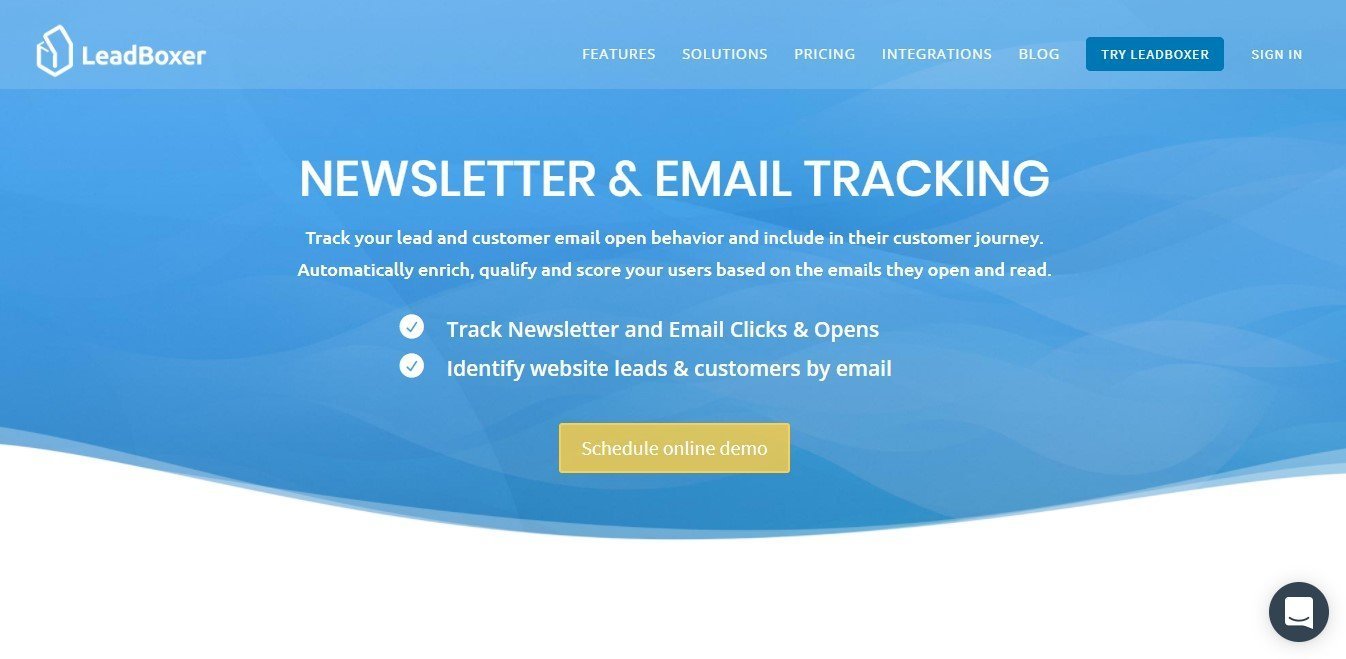
We’ll start this list of software with an introduction to ourselves and our email tracking tool so you know who we are and what LeadBoxer does. LeadBoxer is a lead analytics platform that allows you to see who visits your website, what company they work for, lists that person’s contact information and more.
All of this information is then organized into your “LeadBoard” and each of your different leads are given a score to gauge how engaged they are with your company:
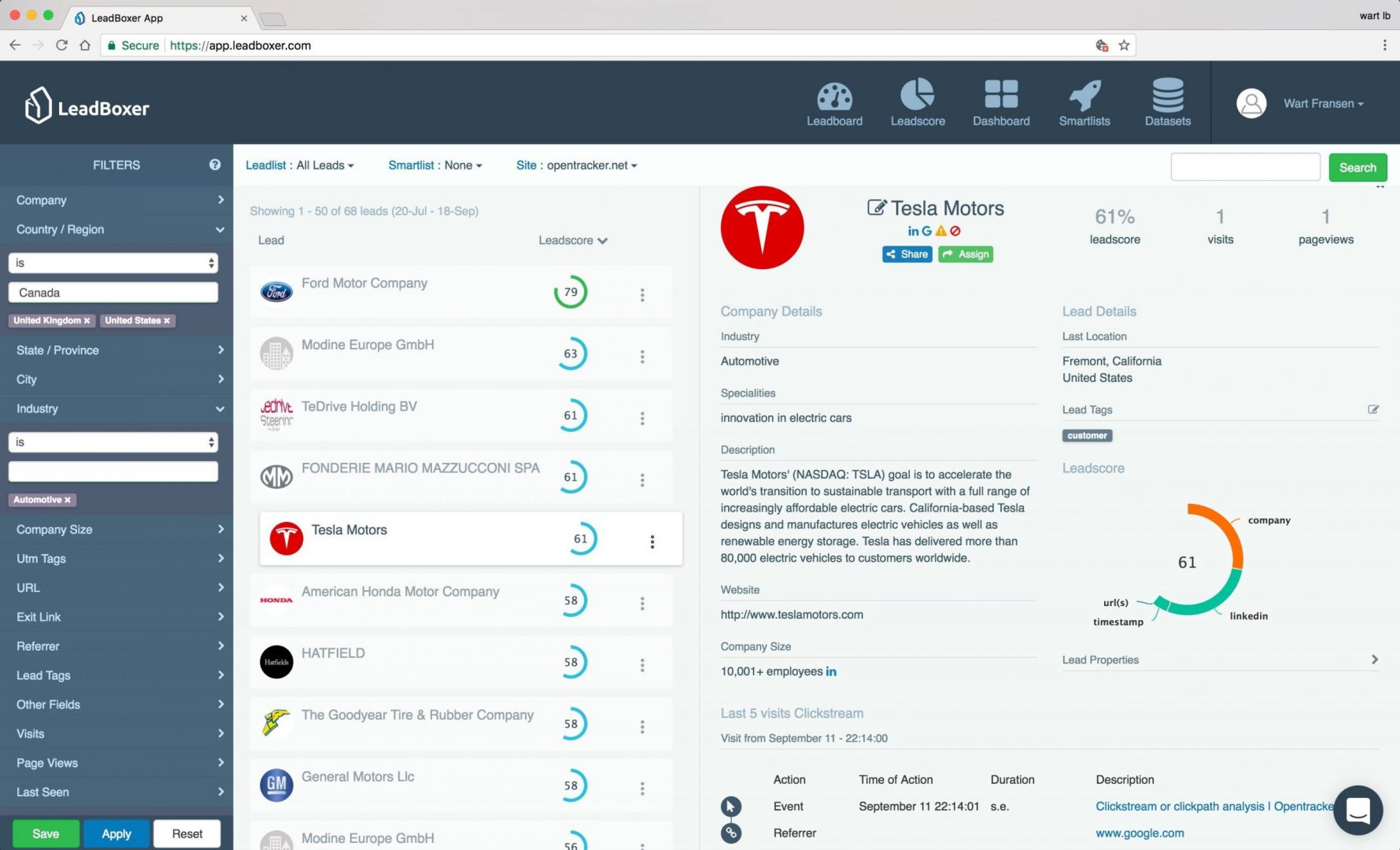
Additionally, email opens and click-throughs can also be tracked. From there, any visits to other pages on your website can be tracked and each action is shown in the history for that lead:
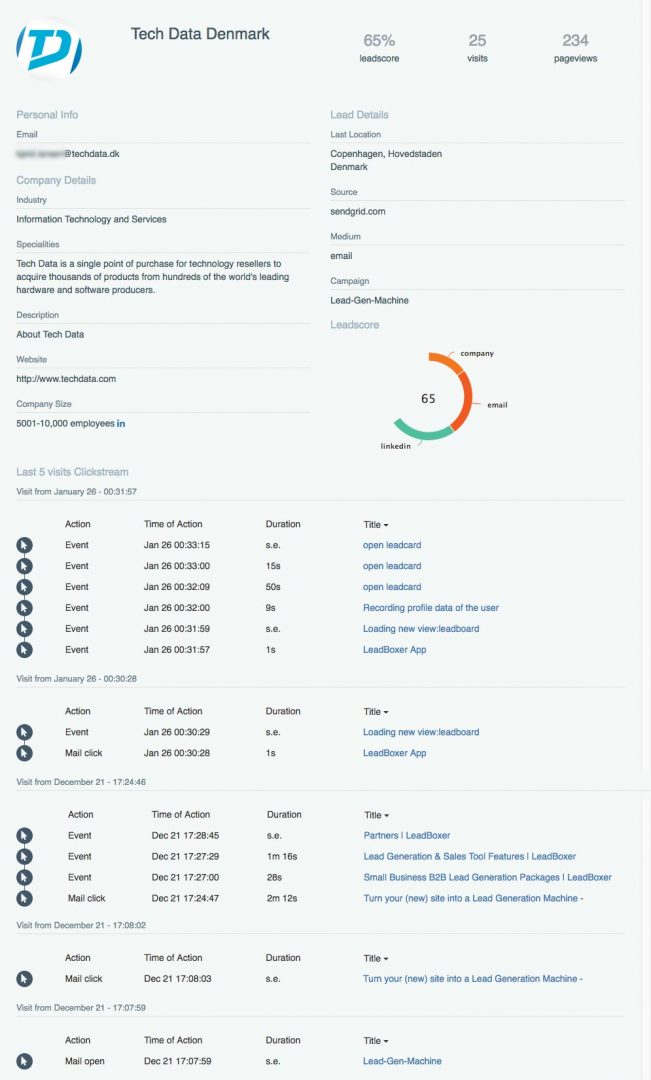
This allows you to see every action that the person has taken since first opening your email.
You can use this information to identify when will be the best time to follow up (for example, if that person has visited your pricing page). You can also identify what emails work, which ones don’t, and where your visitors tend to go after clicking through via your email.
LeadBoxer tracks all of this activity via a tracking pixel (which we’ll discuss how to implement further below)
Therefore, LeadBoxer can be used with any email client or email marketing platform you are using. All you have to is add the tracking pixel link to any links inside your email that you like to track.
This allows you to track activity and identify leads at scale. Pricing starts at $250/month for SMEs. Custom packages are available for larger organizations.
You can learn more on our email tracking features here: Email Lead Generation
Or jump straight to our solutions for Gmail, Outlook, MailChimp, or Others
Note: For all our email tracking features a (free) trial account is available: Start your free-trial here.
SharpSpring
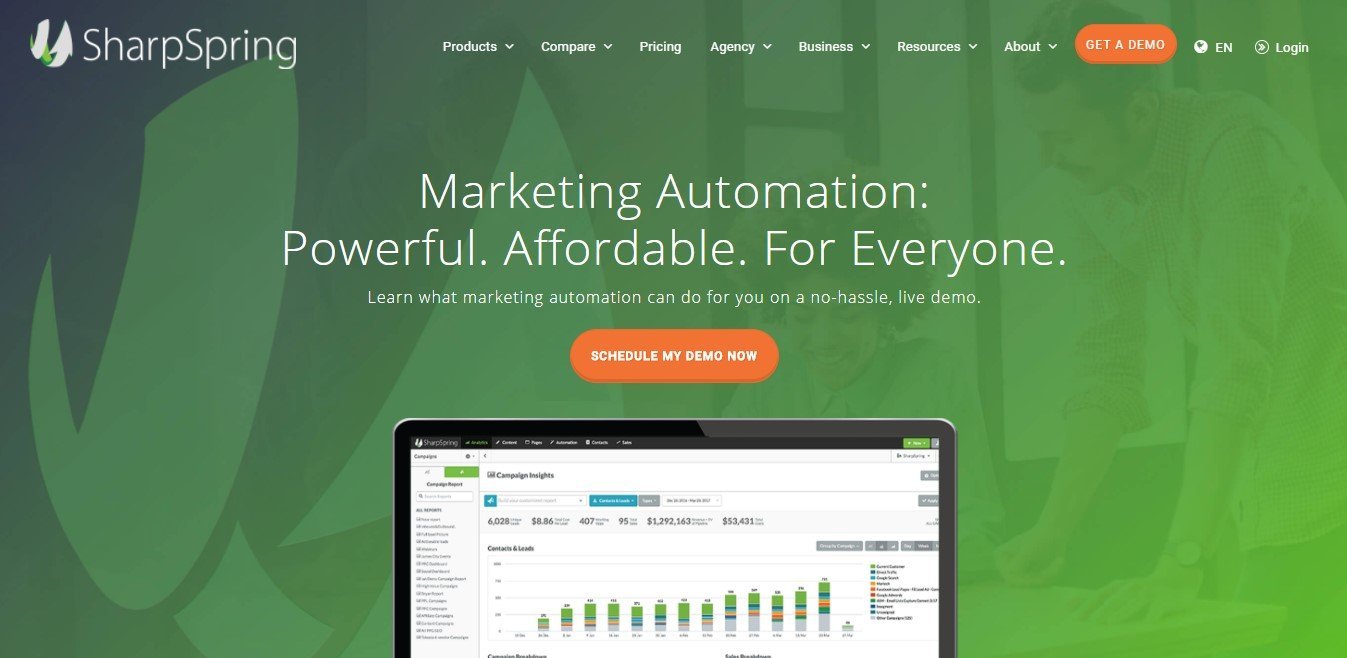
SharpSpring is a full CRM and email marketing platform. With the tool, you can manage contacts, customer relationships, create a content calendar, and send out emails all from the same tool.
In addition to tracking email opens and link clicks, SharpSpring will also track website activity. Therefore, you can see which leads have opened your email and which pages they may have visited directly after viewing your email (or at a later time).
This is all organized into what’s called the “Life of the Lead”. This page shows the entire history of the lead’s interaction with your company. It lists what emails the person has opened, what pages they’ve visited, and so on.
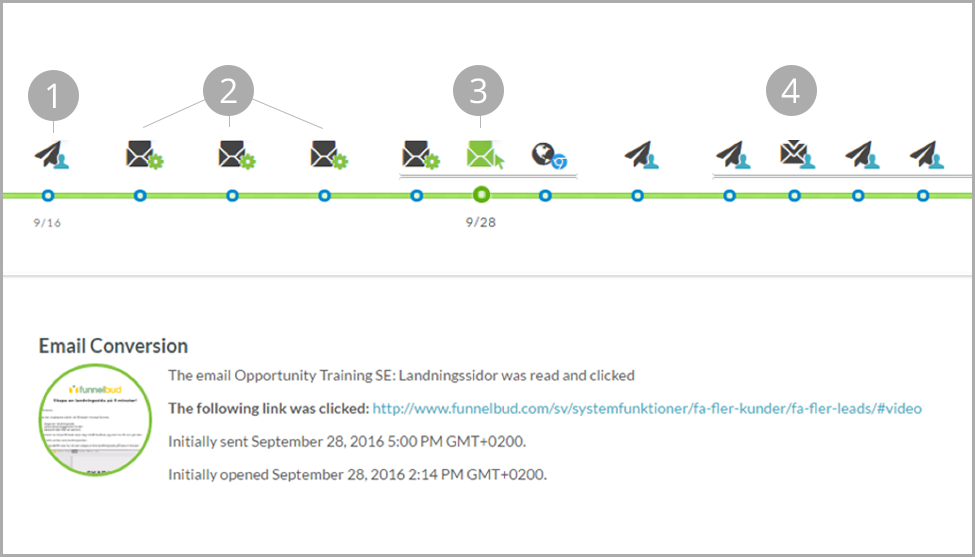
All of this information is then used to create a Lead Score that can be used to identify how engaged that person is and whether or not you should reach out to them.
SharpSpring will be great for teams that want to scale their sales follow up efforts and would like a tool that combines CRM and email automation. However, that amount of power won’t come cheap.
SharpSpring’s plans start at $450/month (for up to 1,500 contacts). Pricing goes up from there based on the number of contacts you have.
Hubspot Sales
![]()
Hubspot Sales’ email tracking allows you to track email opens straight from your Gmail or Outlook account. Setup with Gmail will require you to allow Hubspot to integrate with your inbox. This is done by installing an extension to Google Chrome.
This extension can be clicked to see who has opened your emails and who hasn’t. A notification will also popup when the recipient has opened the email:
![]()
You can also check the history of a lead in the Hubspot dashboard:
![]()
Hubspot’s email tracking feature is free to use to track up to 200 email opens. From there, paid plans for Hubspot Sales start at $50/month.
Hubspot is great for sales people who need a simple approach and want to track opens in Gmail or Outlook. However, it lacks the in-depth details of a platform such as LeadBoxer or SharpSpring.
Additionally, it can only be used with Gmail or Outlook. It can not be used with an email service such as MailChimp.
Yet Another Mail Merge
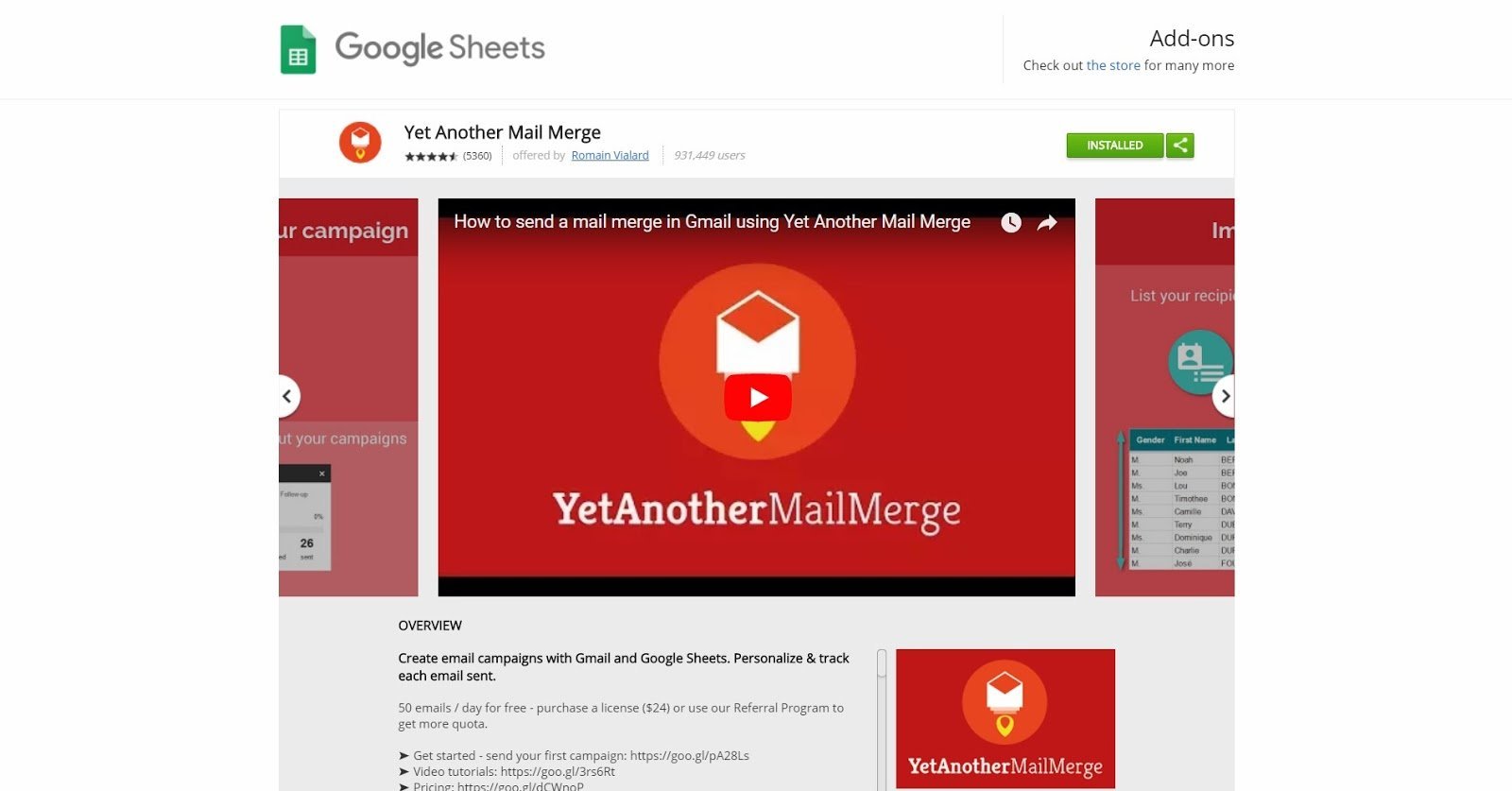
If you send a lot of emails from Gmail and want to track opens, Yet Another Mail Merge can help speed up your process.
Yet Another Mail Merge (YAMM for short) integrates with Google Sheets. To use the add-on, you would create a Google Sheet with information for each person you want to reach out to (separated by row). You would include their email, but you can also include any custom information (such as their name, company, role, etc.).
Then, you can send out an email and use YAMM’s tags to insert that information. For example, you might say “Hey <>” in your email. YAMM will insert the name that you set for that email. This works similar to MailChimp’s “Merge Tags”.
Additionally, the tool will track who has opened your email, who hasn’t, and who has responded. This is all documented right in the Google Sheet you’re working in. You can then create a follow up directly in that Google Sheet and send from a template you create in Gmail.
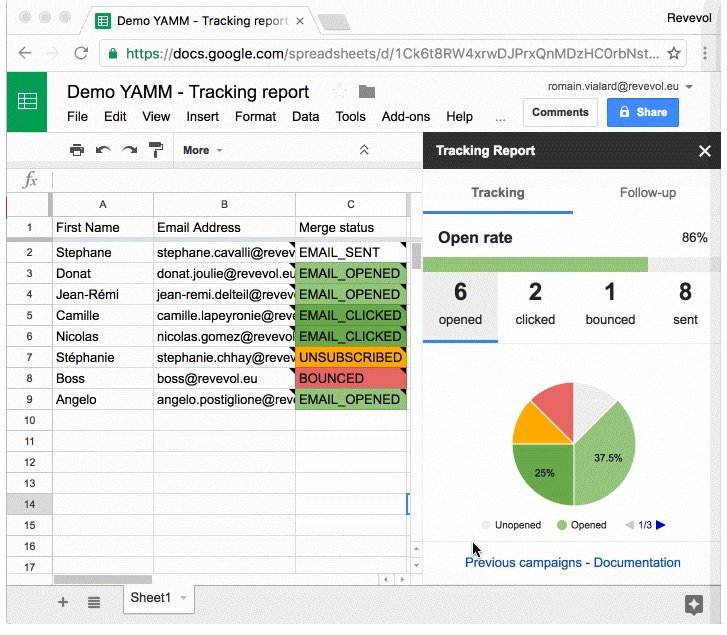
The tool is great for speeding up your process if you currently use Gmail to reach out to leads. However, it will only work with Gmail and it won’t track information on the life of the lead. Thus, it will be difficult for teams to use to scale.
Yesware
Yesware is a tool that will work with Gmail and Outlook only. It is a paid application that starts at $12/month and is installed via a Google Chrome or Mozilla Firefox extension.
The tool is similar to Hubspot’s email tracker. Email tracking can be turned on for a specific email by checking the Track box when using the email composer. However, Yesware does take over your inbox and change the look and layout:
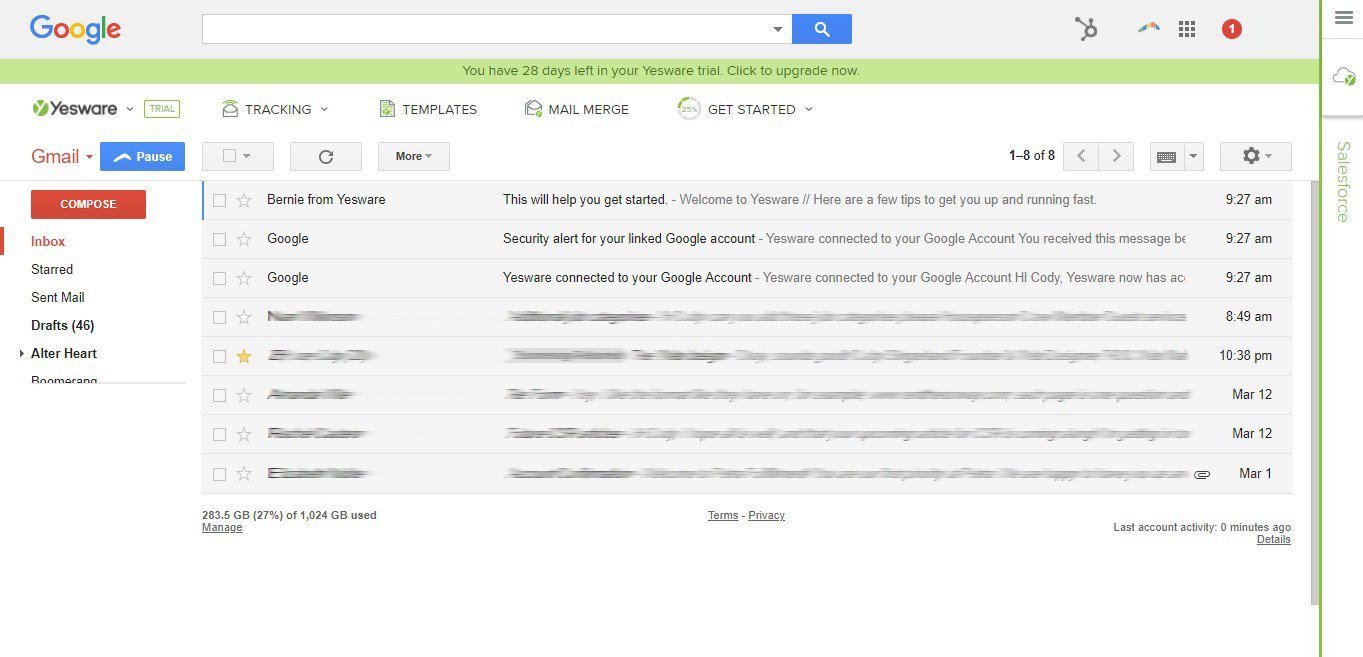
From your email inbox, you can check tracking, templates, and create follow up drip campaigns. Additionally, you can also set reminders for email (much like the way Boomerang works).
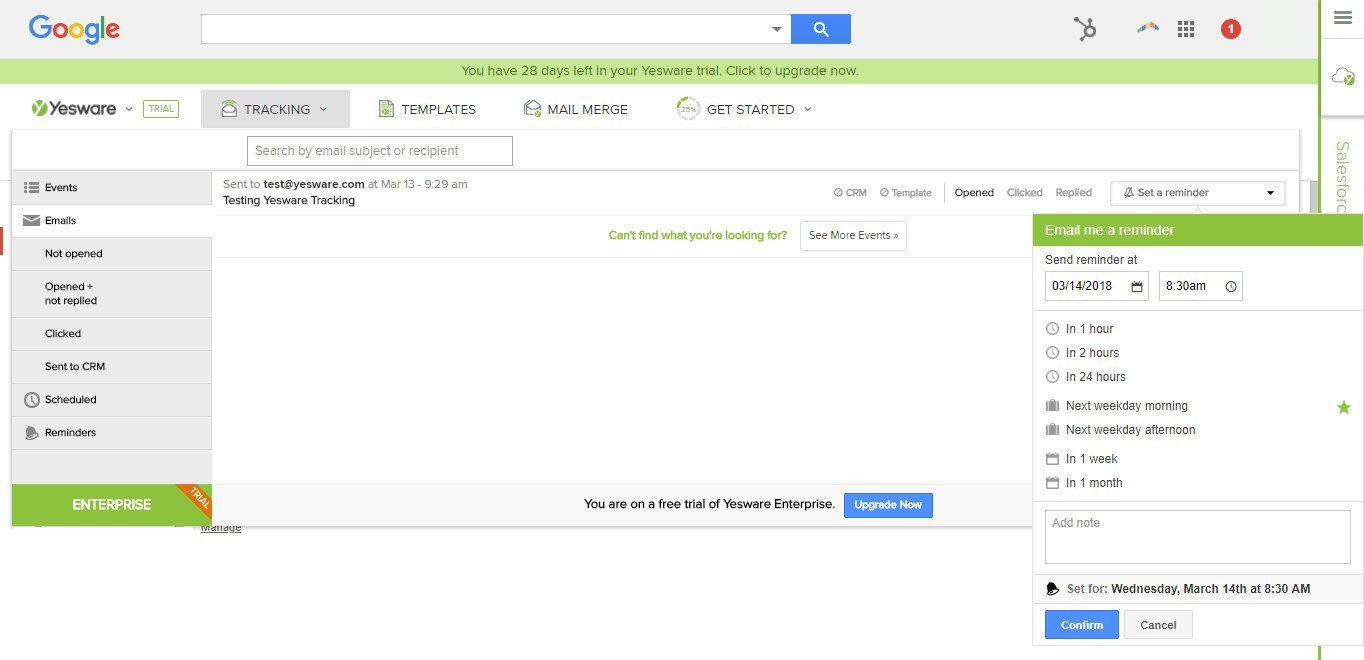
The tool is powerful but is a bit intrusive. Some people may not like the fact that it will change their inbox interface. Additionally, the tool can’t be used with email marketing platforms such as MailChimp to track emails at scale.
Mixmax
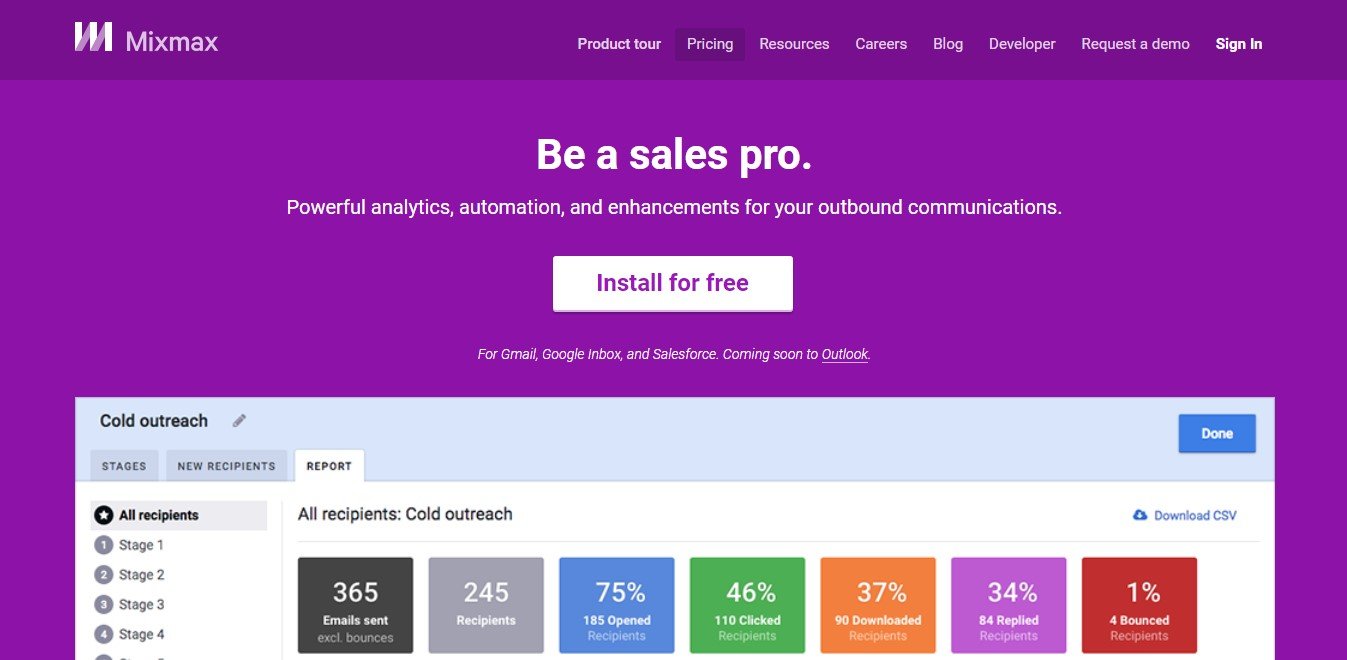
Mixmax is another email tracker that installs via a Chrome Extension. It is not available via Mozilla Firefox or Safari, however.
One of the unique features of Mixmax is the “Enhance” feature inside the email composer of Gmail. Clicking this button will bring up a list of options that will allow you to share calendar availability, create a calendar invite, add a poll, add a custom CTA button, and more directly from the email composer.
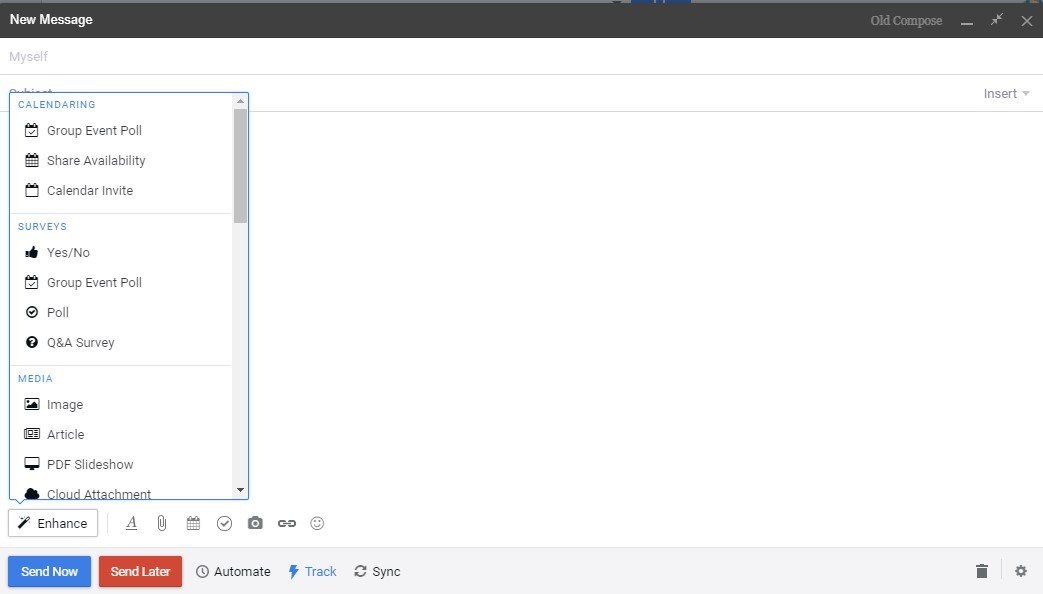
Again, just like Hubspot and Yesware, email tracking can be enabled on a per-email basis. With Mixmax, you can do this by clicking the “Track” icon when composing an email. By default, this will stay enabled until you disable it for a particular email.
Mixmax can be used for free. However, a link will be placed at the end of each email that says “Sent by Mixmax”:
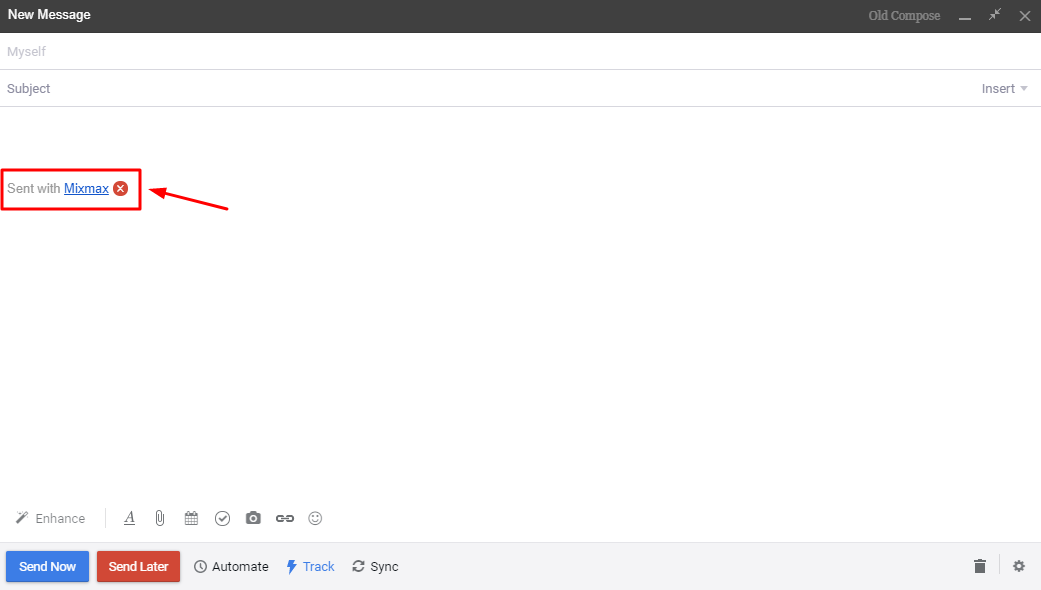
You can remove this link, but you will have to do so everytime you create a new email. Paid plans start at $12/month.
Mixmax will be good for anyone that uses Gmail and likes the features of a tool like Yesware but doesn’t want the intrusive interface that Yesware adds to Gmail. Again, Mixmax will only work with Gmail and can’t be used with email marketing platforms such as MailChimp to track leads at scale.
How to Setup Email Tracking (with an Email Tracking Pixel)
Setting up email tracking is different with each email tracking software. Some companies, such as Hubspot, have a Chrome Extension that will set this up for you if you track emails via Gmail. But as we mentioned above, tools like Hubspot can be a bit limited.
So we want to briefly cover how to setup email tracking with LeadBoxer so that you can track leads over the course of a person’s entire customer journey.
In order to track email opens, LeadBoxer uses a tracking pixel
This tracking pixel is a transparent image with the size of 1×1 pixels that can be embedded in an email. Then, once someone opens that email, the image is downloaded. This is how email tracking can identify when an email has been opened.
From this download, it’s also possible to tell the time and date the email was opened, how many times the email has been opened, and from what type of device the email was opened on.
From with LeadBoxer, this pixel can be generated and needs to be added to the source code of your emails (example below):
![]()
There are 3 parameters within this snippet of code that can to be set: the dataset ID, Campaign Name, and the email of the recipient. The recipient’s email can be added using a Merge tag. This tag will dynamically add a person’s email from your list to this link so that their activity can be tracked. Our generator can be used to easily create your tracking pixel.
For more information on these parameters, Merge tags and using the generator, please visit this article.
Tracking email clicks
The tracking pixel will take care of tracking email opens and reads. From there, to track link clicks and identify customers with it, parameters with merge needs to be added to any link in your email that you’d like to track.
Here’s how the URL will look once the code has been added and a person clicks on that link:

Once the code is added, LeadBoxer will be able to begin collecting data. For example, when a person opens that specific email, this action will be added to the person’s existing customer journey.
This way, you will know exactly when a person has clicked your email and you’ll be able to see their entire history. Also, once this person clicks through via email, they are then identified for all past, present, and future behavior.
Email Tracking Limitations
Of course, there are limitations when it comes to email tracking. The main ones include:
Images Need to be Enabled
With any email tracking software that relies on a tracking pixel to identify opens, in order for email tracking to work, image loading must be enabled by the person’s email client.
Some email clients block external images by default or can be set by the user to not load when opening an email. If this is the case, the pixel will not be loaded and there will be no way to identify whether or not that email was opened (or any other information that can be gather using email tracking).
Your Pixel Could Be Blocked
Just as there is email tracking software, there is also software to prevent email tracking. Pixel Block and Ugly Email will both prevent the email tracking pixel from being loaded. Ugly Email will also let the recipient know if you are using email tracking software and can even identify which software the sender is using.
While it may be rare that your recipients will use an application like this, it’s something to be aware of.
Email Tracking Tips & Best Practices
Lastly, we want to cover a few tips to make email tracking easier for you and hopefully, more successful:
Use Email Templates
Using email templates can help save time when adding tracking links to your email and help you follow up to leads quicker.
For one, having a few email templates that you can edit will save you time having to insert the tracking pixel code to links within the email that never change (for example, a CTA at the bottom of your email).
Additionally, having a few emails ready to go when you need to follow up with a lead will allow you to touch base quicker versus having to waste time trying to think of what to say.
Test Thoroughly
Before sending any tracked emails, make sure to test that everything is working correctly. First, send a tracked email to yourself or other members on your team to ensure that email opens and other track information is being identified.
Encourage Recipient’s to Whitelist Your Email
Whitelisting is an action that can be completed in a person’s inbox to ensure that emails from a specific email address are received and that images are downloaded.
By encouraging your recipient’s to whitelist your email address, you can ensure your emails are being delivered and that images are being download. Therefore, the tracking pixel will also be download, allowing you to track the recipient’s email and web activity.
Develop a Follow Up Strategy
Decide on a follow up strategy before you even send an email to any of your “hot” leads. That way, when someone opens your email or completes another specific action, you’ll already know what to do next.
Decide when will be the best time to follow up. For example, how many times do you want the recipient to open the email before following up? Or, how much time do you want to wait after they’ve opened the email?
Additionally, have some follow up emails already created and ready to go. This will help to save time and allow you to follow up quickly.